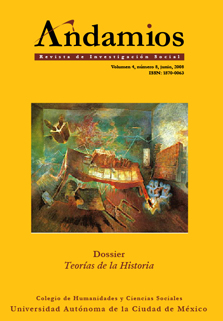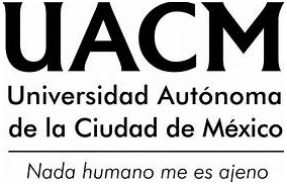CONCEPTUAL LIMITATIONS IN EPIDEMIOLOGY IN THE CLASSIFICATION OF MALE SEXUAL BEHAVIOR IN THE CONTEXT OF THE HIV EPIDEMIC IN MEXICO
DOI:
https://doi.org/10.29092/uacm.v4i8.308Keywords:
Epidemiology, risk analysis, HIV infection, sexual practices, gender role, sexual identityAbstract
The role of epidemiology in the study of Human Immunodeficiency Virus (HIV) and its spread among human populations has been outstanding. The epidemiological theory about “multi-factorial etiology” has allowed the identification of the main “risk factors” of HIV infection, particularly those related to sex practices. Nevertheless, that theory has epistemological limitations to study the social and cultural elements related to sexual behavior in the context of HIV. As a result, we propose to improve the epidemiological theory where the study of sexual behavior is concerned by including gender concepts like sexual identity and sexual role, because these concepts are close to the main objective of sexual behavior study in epidemiology, which is sexual practices.
Downloads
References
ALLPORT, G. W. (1958), The nature of prejudice. New York: Doubleday Anchor Books.
AMUCHÁSTEGUI, A (2001), The hyrbrid construction of sexuality in Mexico and its impact on sex education, en Sex Education, vol. 1. London: Routledge, pp. 259-277.
BACHELARD, G (1990), La formación del espíritu científico. México: Siglo XXI, decimosexta edición en Español.
BECKER, H. S. (1997), Outsiders: Studies in the sociology of deviance. United States: The Free Press.
BLOOR, M (1995), The sociology of HIV transmission. Great Britain: Sage Publications.
CARRIER, J. M. (1976), “Cultural factors affecting urban Mexican male homosexual behavior”, en Archives of Sexual Behavior, vol. 5. Estados Unidos: Kluwer Academic/Plenum Publishers, pp. 103- 124.
--------(1989), “Sexual behavior and the spread of AIDS in Mexico”, en Medical Anthropology Quarterly, vol. 10. Estados Unidos: Society for Medical Anthropology, pp. 129-142.
CENTERS FOR DISEASE CONTROL (1981), “Pneumocystis pneumonia”, en MMWR, 30. Los Angeles, pp. 250-152.
--------(2001), “HIV incidence among young men who have sex with men in seven US cities, 1994-2000”, en MMWR, 50. Los Angeles, pp. 440-444.
CONNELL, R. W. (2003), Masculinidades. México: Universidad Nacional Autónoma de México.
COPLAN P. M., S. GORTMAKER, M. HERNÁNDEZ-AVILA, et al. (1996), “Human immunodeficiency virus in Mexico. Rectal bleeding an anal warts as risk factors Among men reporting sex with men”, en American Journal of Epidemiology, vol. 144. Maryland, Estados Unidos: Johns Hopkins Bloomberg School of Public Health, pp. 817-827.
CURRAN, J. W., W. M. MORGAN, A. M. HARDY, et al. (1985), “The epidemiology of AIDS: Current status and future prospects”, en Science, vol. 229. Estados Unidos: American Association for the Advancement of Science, pp. 1352-1357.
DEVERALL, K. y A. PROUT (1999), “Sexuality, identity and community: the experience of MESMAC”, en: Parker, R. y P. Aggleton (eds.), Culture, society and sexuality. A reader. London: Routledge.
DOLL, R. y R. PETO (1981), The causes of cancer. Oxford: Oxford University Press.
FISCHL, M. A. y G. M. DOCKINSON (1984). “An acquired immu-nodeficiency syndrome among Haitians: An update”, en Annals of the New York Academy of Sciences, 437, pp. 325-332.
FOUCAULT, M. (1981), Historia de la sexualidad, t. 1.- La voluntad de saber. México: Siglo XXI.
GOFFMAN, I. (1995), Estigma: la identidad deteriorada. Buenos Aires: Amorrortu.
GORTMARKER, S. L. y J. A. IZAZOLA (1992), “The role of quantitative be- havioral research in AIDS prevention”, en Sepúlveda, J., H. Fineberg, J. Mann (eds.), AIDS. Prevention through education: a world view. United States: Oxford University Press, pp. 37-56.
HAYES, M. V. (1992), “On the epistemology of risk: language, logic, and social science”, en Social Science and Medicine, vol. 35. England: Pergamon Press. pp. 401-407.
HERNÁNDEZ-AVILA,M.,P.URIBE ZÚÑIGA,S.GORTMAKER,etal.(1992),“Sexual behavior and status for human immunodeficiency virus type 1 among homosexual and bisexual males in Mexico City”, en American Journal of Epidemiology, vol. 135. Maryland, Estados Unidos: Johns Hopkins Bloomberg School of Public Health, pp. pp. 883-94.
IZAZOLA, J. A. (1994), “La bisexualidad”, en Antología de la sexualidad humana, t. I. México: CONAPO/Porrúa, pp 633-671.
IZAZOLA-LICEA, J. A., J. S. VALDESPINO-GÓMEZ, J. SEPÚLVEDA-AMOR (1988), “Factores de riesgo asociados a infección por VIH en hombres homosexuales y bisexuales”, en Salud Pública de México, 30. México, pp. 555-566.
IZAZOLA-LICEA, J. A., J. L. VALDESPINO-GOMEZ, S. L. GORTMAKER, et al. (1991), “HIV-1 seropositivity and behavioral and sociological risks among homosexual and bisexual men in six Mexican Cities”, en Journal of Acquired Immune Deficiency Syndromes, volumen 4. Estados Unidos: Lippincott Williams & Wilkins, Inc., pp. 614-622.
IZAZOLA-LICEA, J. A., C. AVILA-FIGUEROA, S. L. GORTMAKER, et al. (1995), “Transmisión homosexual del VIH/SIDA en México”, en Salud Pública de México, 37, pp. 602-614.
IZAZOLA-LICEA, J. A., S. L. GORTMAKER, V. DE GRUTTOLA, et al. (2003), “Sexual behavior patterns and HIV risk in bisexual men compared to exclusively heterosexual and homosexual men”, en Salud Públi- ca de México, 45, pp. S662-S671.
KINSEY, A. C., W. B. POMEROY, C. E. MARTIN (1948), Sexual behavior in the human male. United States of America: W. B. Saunders Company. KRIEGER, N. (1994), “Epidemiology and the web of causation: has anyone seen the spider?”, en Social Science and Medicine, vol. 39. England: Pergamon Press, pp. 887-903.
--------(2001), “A glossary for social epidemiology”, en Journal of Epidemiology Community Health, vol. 55. England: British Medical Association, pp. 693-700. pp. 693-700.
--------(2003), “Genders, sexes, and health: what are the connections- and why does it matter?”, en International Journal of Epidemiology, Vol. 32. England: Oxford University Press, pp. 652-657.
LANCASTER, R. N. (1988), “Subject honor and object shame: the construction of male homosexuality and stigma in Nicaragua”, Ethnology, Volumen XXVII, Pittsburgh, EU: University of Pitts- burgh, pp. 111-125.
LAST, J. M. (2001), A dictionary of epidemiology. New York: University Press.
LIGUORI, A. L. (1995), “Las investigaciones sobre bisexualidad en México”, en Debate Feminista, Vol. 11, Año 6. México: Metis Productos Culturales, S.A. de C.V., pp. 132-156.
LUMSDEN, I. (1991), Homosexualidad, Sociedad y Estado en México (traducido al Español por Luis Zapata). Toronto: Canadian Gay Archives y México: Solediciones.
LUPTON, D. (1999), Risk. New York: Routledge. MAGIS, C., M. L.
GARCÍA, G. GONZÁLEZ, et al. (1992), “Underreport of homosexuallity affects epidemiological patterns of AIDS/HIV in a Latin America country”. VI International Conference on AIDS/ HIV STD Word Congress. Amsterdam (abstract PoC4768:C371).
MALEBRANCHE, D. J. (2003), “Black men who have sex with men and the HIV epidemic: next steps for Public Health”, en American Journal of Public Health, Volumen 93. Estados Unidos: American Public Health Association, pp. 862-865.
Manual para la vigilancia epidemiológica VIH-SIDA (1990). México: SSA/ DGE/INDRE.
MINELLO, N. (2002), “Los estudios de masculinidad”, en Estudios So- ciológicos, XX. México: El Colegio de México, pp. 715-732.
MURRAY, S. O., K. W. PAYNE (1989), “The social classification of AIDS in American epidemiology”, en Medical Anthropology, Vol. 10. Estados Unidos: Taylor & Francis, pp. 115-128.
NÚÑEZ, G. (2001), “Reconstruyendo los placers, deconstruyendo las identidades. Antropología, patriarcado y homoherotismos en México”. Revista Mexicana de Antropología, Primavera-Verano. México, pp. 15-34.
OAKLEY, A. (1972), Sex, Gender and Society. Great Britain: Temple Smith.
PARKER, R. (1987), “Acquired immunodeficiency syndrome in urban Brazil”, en Medical Anthropology Quarterly, vol. 1. Estados Unidos: Society for Medical Anthropology, pp. 155-175.
PARKER y AGGLETON (2003), “HIV and AIDS-related stigma and discrimination: a conceptual framework and implications for action”, en Social Science and Medicine, Vol. 57. England: Pergamon Press, pp. 13-24.
PAZ, O. (1973), El laberinto de la soledad. México: Fondo de Cultura Económica.
ROSS, M. W., E. J. ESSIEN, M. L. WILLIAMS, et al. (2003), “Concordance between sexual behavior and sexual identity in street outreach samples of four racial/ethnic groups”, en Sexually Transmitted Diseases, Vol. 30. Estados Unidos: JB Lippincott, pp. 110-113.
ROTHMAN, K. J., S. GREENLAND (1998), “The emergence of modern epidemiology”, en Rothman, K. J. y S. Greenland, Modern epi- demiology. United States of America: Lippincott Williams & Wilkins, pp 3-6.
SHY, C. M. (1997), “The failure of academia epidemiology: Witness for the prosecution”, en American Journal of Epidemiology, Volumen 145. Estados Unidos: Oxford University Press, pp. 479-484.
SUSSER, M. y E. SUSSER (1996), “Choosing a future for epidemiology: I. Eras and paradigms”, en Am J Public Health, vol. 86. Estados Unidos: American Public Health Association, pp. 668-73, pp. 668-73.
TONG, R. (1998), Feminist tough: a more comprehensive introduction. United States: Paperback.
URIBE, F. (2004), Comportamiento sexual y VIH/SIDA en sujetos masculinos. Análisis del comportamiento sexual de individuos VIH positivos como punto de partida para entender la transmisión del virus en la re- gión sur del estado de Chiapas. Tesis para obtener el grado de Doctor en Ciencias Sociales por el Colegio de la Frontera Norte. Tijuana, B. C., octubre de 2004.
WATNEY, S. (1993), “Emergent sexual identities and HIV/AIDS”, en Aggleton, P., P. Davies, G. Hart (eds), AIDS: facing the second decade. London: Falmer Press.
WEEKS, J. (1998), “La construcción de las identidades genéricas y sexuales. La naturaleza problemática de las identidades”, en: SAS, I. y S. Lerner (Comp.), Sexualidades en México. Algunas aproximaciones desde la perspectiva de las ciencias sociales. México: El Colegio de México, pp 199-221.
Published
Issue
Section
License
This Journal is licensed under Creative Commons Mexico 2.5. It is allowed to reproduce and disseminate the contents of the Journal for educational or research purposes, not for profit, as long as they are not mutilated and cite the source (Andamios, Revista de Investigación Social) and the author.
The copyright of the articles published in Andamios, Revista de Investigación Social are transferred by the author(s) to Universidad Autónoma de la Ciudad de México when the originals have been accepted, so that they are published and distributed both in the printed and electronic versions of the Journal. However, as established by law, the author(s) retains their moral rights. The author(s) will receive a form of assignment of copyright that they must to sign when their original has been accepted. In the case of collective articles, the signature of one of the authors will suffice, provided that the latter has obtained the consent of the others.
Authors may use the material of their article in other works or books published by themselves, with the condition of quoting Andamios as the original source of the texts.
The articles contained in this publication are the responsibility of their authors and do not compromise the official position of Andamios, Revista de Investigación Social of the Universidad Autónoma de la Ciudad de México.


